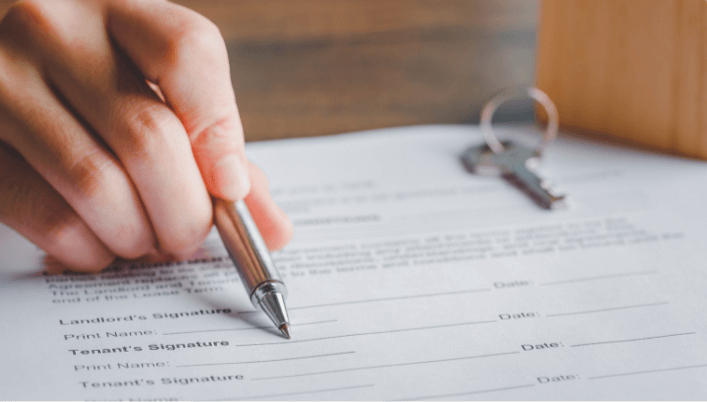
When entering into a tenancy agreement (TA), it is essential for both landlords and tenants to fully understand their rights and responsibilities.
A tenancy agreement is a legally binding contract that outlines the terms and conditions of the rental arrangement.
This article aims to provide a comprehensive overview of the key aspects of a tenancy agreement, helping both landlords and tenants navigate the process with confidence.
Key Takeaways
- Introduction to Tenancy Agreement (TA): A TA is a crucial legal contract that outlines the rights and responsibilities of both tenants and landlords. It’s essential for maintaining a fair and transparent relationship in the real estate industry.
- Overview of a Tenancy Agreement (TA): A TA, also known as a lease agreement, covers essential aspects like lease duration, rental amount, and responsibilities. In Singapore, a standard template is often used with modifications to suit specific needs.
- Importance of Having a Tenancy Agreement (TA): TAs provide clarity and protect both tenants and landlords. They outline responsibilities and consequences, making dispute resolution easier.
- Understanding the Purpose and Scope of a Tenancy Agreement (TA): TAs establish a mutually beneficial relationship, covering various aspects like rent, security deposit, maintenance, and termination conditions.
- Signing of the Tenancy Agreement: The process involves expressing interest, payment, signing, handling security deposits, and addressing repair and maintenance responsibilities.
- Key Considerations for Tenants when Signing a TA: Tenants should understand obligations, subletting rules, lease duration, exclusive possession, and CEA requirements (in Singapore).
- Payment and Signing: Understand payment methods, financial transactions, payment schedules, and early termination conditions before signing.
- Important Clauses Included in the Tenancy Agreement: Key clauses include standard terms, rights and duties, early termination, security deposit, diplomatic clause, and dispute resolution.
- Tenant and Landlord Rights and Responsibilities: Both parties have responsibilities, such as maintaining the property and adhering to lease terms. Tenants should also understand the diplomatic clause and other legal considerations.
- Stamp Duty and Legal Considerations: Stamp duty is a tax imposed on TAs, typically paid by tenants. Understanding recent developments, recommended reads, and legal aspects of TAs is vital.
Introduction to Tenancy Agreement (TA)

When it comes to renting a property, it is crucial for both the tenant and the landlord to have a clear understanding of their rights and obligations.
This is where a Tenancy Agreement (TA) comes into play.
A tenancy agreement is a legal contract that outlines the rights and responsibilities of both the tenant and the landlord.
In Singapore, for instance, when renting a HDB flat, it is important to have a tenancy agreement in place to protect both parties involved.
This agreement typically covers details such as the duration of the lease, the monthly rental amount, and any additional terms or conditions.
One important aspect often discussed in a tenancy agreement is the concept of “wear and tear.
” This refers to the gradual depreciation or deterioration of the property due to normal use.
For example, small damages to walls, floors, or furniture caused by regular day-to-day activities.
The tenancy agreement should state clearly who is responsible for repairing any wear and tear that occurs during the tenant’s occupancy.
It is advisable to consult a property agent or a lawyer when drafting or reviewing a tenancy agreement to ensure that both parties are protected and aware of their rights and obligations.
Typically, tenancy agreements in Singapore have a duration of 12 months, and it is essential for all clauses and terms to be clearly defined and agreed upon to avoid any potential disputes.
Overall, a well-drafted tenancy agreement plays a crucial role in the real estate industry to maintain a fair and transparent relationship between landlords and tenants.
Overview of a Tenancy Agreement (TA)
A Tenancy Agreement, also known as a lease agreement, is a legally binding document that outlines the terms and conditions of the tenancy.
It covers important aspects such as the duration of the tenancy, the rental amount, and the responsibilities of both the tenant and the landlord.
In Singapore, a standard Tenancy Agreement template is often used as a starting point, with necessary modifications to suit the specific needs of the parties involved.
It is crucial to include key details in a Tenancy Agreement, such as the diplomatic clause, which protects tenants who are posted overseas for work.
The security deposit, which is typically one to two months’ rent, is also included to safeguard the landlord’s interests in case of damage or unpaid rent.
Additionally, an inventory list of items present in the property should be attached to the agreement to avoid disputes in the future.
Importance of Having a Tenancy Agreement (TA)
Having a Tenancy Agreement is essential for both tenants and landlords.
It provides a clear framework for the landlord-tenant relationship, ensuring that both parties understand their rights and obligations.
In case of any disputes or disagreements, the Tenancy Agreement serves as a reference point to resolve them amicably.
For tenants, a Tenancy Agreement gives them peace of mind by outlining the landlord’s responsibilities, such as property repairs and maintenance.
It also provides clarity on the consequences of unpaid rent or violating any clauses in the agreement.
For landlords, a Tenancy Agreement protects their property and financial interests.
It allows them to set out rules and regulations, ensuring that tenants adhere to them during their stay.
In case of any damages or unpaid rent, the agreement provides a legal basis for the landlord to take appropriate action.
Understanding the Purpose and Scope of a Tenancy Agreement (TA)
The purpose of a Tenancy Agreement is to establish a mutually beneficial relationship between the landlord and the tenant.
It sets out the rights and responsibilities of both parties, creating clarity on what is expected during the tenancy period e.
g
The scope of a Tenancy Agreement covers various aspects, including the rental amount, payment schedule, security deposit, repair and maintenance responsibilities, and termination clause.
It is crucial for both parties to read and understand the terms and conditions stated in the agreement before signing it.
In conclusion, a Tenancy Agreement plays a vital role in ensuring a smooth landlord-tenant relationship.
It provides a framework for both parties to legally protect their interests and responsibilities, making the renting process more transparent and secure.
Signing of the Tenancy Agreement

Within the tenancy agreement, it is essential to understand the terms and conditions that govern the tenancy.
The agreement states the rights and responsibilities of both the landlord and the tenant.
In the context of private residential properties, the Association of Singapore is committed to upholding the highest standards of property management.
The tenancy agreement may include clauses related to specific obligations of the tenant, such as the maintenance of the property and adherence to the rules and regulations set by the association.
Moreover, the agreement may also outline the tenant’s covenants, emphasizing their duty to keep the property in good condition and promptly report any damages or repairs needed.
It is crucial to note that fair wear and tear, which refers to expected deterioration from ordinary usage, is typically exempted from the tenant’s liability.
By adhering to the provisions outlined within the tenancy agreement, both landlords and tenants can ensure a harmonious and mutually beneficial relationship throughout the tenancy period.
Process and documentation involved in signing a TA
Signing a Tenancy Agreement (TA) involves a few important steps and documentation.
The process typically starts with the tenant expressing interest in renting the property and ends with both parties signing the agreement.
Here are the key considerations:
- Rental Agreement: The rental agreement outlines the terms and conditions of the tenancy, including the monthly rent, duration of the lease, and any additional clauses.
- Payment and Signing: Once both parties reach an agreement, the tenant is usually required to pay a security deposit and the first month’s rent. The agreement is signed by both the landlord and the tenant.
- Security Deposit: The security deposit is a sum of money held by the landlord as protection against any damage or unpaid rent. It is usually equivalent to a specified number of months’ rent.
- Repair and Maintenance: The TA should include information about who is responsible for minor repairs and maintenance tasks. This helps clarify the obligations of both parties during the tenancy.
- Inventory List: It is common for landlords to provide an inventory list detailing the condition of the property and its contents. The tenant should carefully review and document any discrepancies before signing the TA.
- Entry and Quiet Enjoyment: The TA should specify the terms under which the landlord can enter the premises, ensuring that the tenant’s right to privacy and quiet enjoyment is protected.
Key considerations for tenants when signing a Tenancy Agreement
Tenants should be aware of their rights and responsibilities before signing a Tenancy Agreement. Here are some key considerations:
- Tenant and Landlord Obligations: Both parties have certain obligations outlined in the TA. Tenants should familiarize themselves with these obligations to avoid breaches and disputes.
- Subletting: Tenants should check if subletting is allowed or if they need the landlord’s permission before subletting the property.
- Lease Duration: The TA should clearly state the lease duration, whether it is a fixed-term lease or a periodic lease.
- Exclusive Possession: Tenants should ensure that they have exclusive possession of the property during the tenancy period.
- CEA Requirements: In Singapore, if the tenancy period is less than three years, the landlord must engage a licensed estate agent registered with the Council for Estate Agencies (CEA) for the agreement.
- Dispute Resolution: The TA should provide a clause for resolving disputes between the landlord and tenant, such as mediation or arbitration.
Tenants are encouraged to seek legal advice or refer to standard tenancy agreement templates provided by authorized organizations for their peace of mind.
Payment, and Signing

Understanding the payment terms and conditions in a Tenancy Agreement
When it comes to renting a property, understanding the payment terms and conditions in a Tenancy Agreement (TA) is crucial. Here are some key points to consider:
- Payment Method: The TA should specify the acceptable methods of payment for rent, such as bank transfers or checks. Make sure you are comfortable with the chosen method.
- Financial Transactions: Understand what financial transactions are involved, such as the amount of rent, security deposit, and any additional fees. It’s important to have a clear understanding of all financial obligations before signing the TA.
- Payment Schedule: The TA should outline the payment schedule, including the frequency (e.g., monthly) and due dates. Make sure you are aware of when and how much you need to pay.
- Early Termination: Familiarize yourself with the terms and conditions regarding the early termination of the tenancy. There may be penalties or notice periods that need to be followed if you wish to end the agreement before the specified period.
Step-by-step guide to signing a TA
Signing a Tenancy Agreement involves several steps to ensure a smooth process:
- Payment and Signing: Once both the tenant and landlord are satisfied with the terms, a payment is made, usually comprising the first month’s rent and a security deposit. The tenant should keep a copy of the payment receipt.
- Tenancy Agreement and Security Deposit: The TA should clearly state the amount of the security deposit and how it will be handled during and after the tenancy period. Understand the conditions under which the deposit will be refunded.
- Rental Clauses: Read and understand the rental clauses, which outline the rights and responsibilities of both the tenant and landlord. Pay attention to clauses related to repairs, maintenance, and any additional obligations.
- Termination Clause: Take note of the termination clause, which specifies the period of time and notice period required for either the tenant or the landlord to terminate the agreement.
By understanding the payment terms and following the step-by-step guide to signing a TA, both tenants and landlords can ensure a clear and fair rental agreement.
It’s important to take the time to read and clarify any doubts before signing the TA to avoid any potential disputes or misunderstandings in the future.
Important Clauses Included in the Tenancy Agreement

As a tenant or landlord, it is essential to have a comprehensive tenancy agreement (TA) in place.
This legally binding contract protects both parties’ rights and ensures a smooth and harmonious tenancy. Here are some important clauses commonly found in a TA:
Overview of Common Clauses Found in a TA
- Standard Tenancy Agreement: The TA should include all necessary provisions to protect the interests of both the tenant and landlord. It typically covers details such as the parties involved, property description, rental term, and rental amount.
- Party’s Rights and Duties: This clause outlines the rights and responsibilities of both the tenant and landlord. It includes obligations related to the use of the property, maintenance, repair, and payment of utilities.
- Early Termination: In the event of early termination, this clause specifies the conditions and penalties involved. It is crucial to understand the terms and conditions before signing the agreement to avoid any disputes in the future.
- Security Deposit: The TA should clearly state the amount of the security deposit and the conditions for its return. This includes provisions for damages, cleaning fees, or outstanding rental payments.
- Diplomatic Clause: For expatriate tenants, a diplomatic clause allows for early lease termination in the event of job relocation or unforeseen circumstances. It is vital to carefully review this clause and negotiate its terms if necessary.
- Dispute Resolution: It is wise to include a clause specifying the preferred method of dispute resolution, such as mediation or arbitration. This reduces the chances of lengthy legal proceedings and promotes a smoother resolution process.
- Stamp Duty: Ensure compliance with local laws by including a clause detailing the payment of stamp duty. In some jurisdictions, the tenant may be responsible for the duty.
It is important for both tenants and landlords to carefully review and understand the clauses included in the TA before signing.
Seeking legal advice and conducting thorough research can help ensure a fair and mutually beneficial tenancy agreement.
Tenant and Landlord Rights and Responsibilities Repair

Understanding the rights and responsibilities of both tenants and landlords under a Tenancy Agreement
Finding the perfect place to rent can be exciting, but before you can settle in, you’ll need to sign a Tenancy Agreement (TA).
This legally binding document outlines the rights and responsibilities of both the tenant and the landlord.
It’s important for all parties involved to understand their obligations to avoid future disputes.
When entering into a rental agreement, it is essential for tenants to familiarize themselves with the landlord’s covenants.
These covenants outline the rights and responsibilities of both parties involved in the lease.
Being aware of these provisions is crucial as it determines the scope of the contractual relationship.
For instance, if a tenant signs a two-year lease, both parties must agree on a fixed rental amount for the entirety of that period.
This ensures stability for both the landlord and the renter.
Tenants should also be cautious to avoid making any alterations or changes to the property without the landlord’s consent as this may violate the terms of the lease.
In case of any damages incurred due to the tenant’s negligence, the landlord has the right to charge the tenant for repairs and reimburse the cost.
Therefore, it is vital for renters to thoroughly read and comprehend the landlord’s covenants to ensure a smooth and trouble-free rental experience.
When it comes to financial matters, it is crucial to be well-informed and cautious.
This is particularly true in the context of renting property.
As a tenant, it is absolutely necessary to have a clear understanding of how much you are expected to pay and what the potential repercussions may be.
Without this knowledge, you risk finding yourself in a vulnerable position, unable to assert your rights or protect your interests.
Additionally, landlords may take advantage of this lack of information and exploit it to their advantage.
It is imperative to ensure that all costs and conditions are clearly spelled out in the rental agreement to avoid any confusion or unexpected expenses.
Furthermore, tenants should be mindful of the possibility of reselling the property before the lease term expires, as certain landlords may impose restrictions or penalties in such cases.
Lastly, if you are considering renting property in another country, it is even more crucial to familiarize yourself with the local laws and regulations to avoid any legal consequences or disputes.
Landlord’s Responsibilities
- Providing a safe and habitable property: The landlord is responsible for ensuring that the property is in good condition and meets all safety requirements. This includes maintaining electrical wiring, plumbing, and other essential systems.
- Addressing disturbances from outsiders: Landlords should take action if there are disturbances caused by neighbors or other individuals that affect the tenant’s peaceful enjoyment of the property.
- Holding the security deposit: Landlords are required to hold the tenant’s security deposit and return it at the end of the tenancy according to the agreed terms and conditions.
Tenant’s Responsibilities
- Keeping the property in good condition: Tenants are responsible for maintaining the property in a clean and tidy condition. This includes reporting any damages to the landlord promptly.
- Following the terms of the lease: Tenants should adhere to the rules and regulations specified in the Tenancy Agreement. This includes paying rent on time and not causing disturbances or damages to the property.
- Understanding the diplomatic clause: If you are a foreign tenant, it’s important to understand the terms and conditions of the diplomatic clause, which may allow for early termination of the lease due to unforeseen circumstances.
It’s advisable for tenants and landlords to discuss any specific concerns or requirements upfront and have them included in the Tenancy Agreement.
This ensures clarity and can help prevent misunderstandings in the future.
Whether you’re a tenant or a landlord, understanding your rights and responsibilities is essential for a smooth tenancy.
If any disputes arise, it’s recommended to seek legal advice or mediation to reach a fair resolution.
For more information on tenancy agreements or related articles, you can visit official government websites or consult with professionals familiar with the regulations in your country or region.
Stamp Duty and Legal Considerations
When it comes to signing a tenancy agreement (TA), there are several legal considerations that both tenants and landlords need to be aware of.
One of these considerations is stamp duty.
Explaining the concept of stamp duty and its relevance to TAs
Stamp duty is a tax imposed by regulatory agencies or industry associations on legal documents like TAs.
In the context of TAs, stamp duty is required to be paid by the tenant.
It is calculated based on the rental amount and the duration of the tenancy.
The stamping process involves applying for a stamp certificate from the authorities to ensure that the document is legally valid.
Summary of recent developments and changes related to TAs
In recent times, there have been various changes and developments related to TAs that both tenants and landlords should be aware of.
For example, there have been legislative changes that affect things like the payment schedule, rental deposit, and terms of the agreement.
Additionally, there have been changes in relation to expatriate tenants, including the introduction of a one-year lease requirement and the need for sufficient notice when terminating the tenancy.
Recommended reads for further understanding of TAs and related topics
For those seeking a deeper understanding of TAs and related topics, there are several recommended reads available.
These include articles from reputable sources like 99.
co and estate agencies, as well as resources from tenant associations.
Some specific topics to explore include the different types of tenancy agreements (such as 1-year and 2-year contracts), considerations for rental agreements, and the rights and responsibilities of both tenants and landlords.
Understanding stamp duty and the legal considerations surrounding TAs is crucial for both tenants and landlords.
By being informed about recent developments, reading up on related articles, and seeking advice from professionals, both parties can ensure that they enter into a tenancy agreement that is fair, transparent, and legally binding.
Latest News and Updates on Tenancy Agreements

Keeping up with the latest news and updates on tenancy agreements is crucial for tenants and landlords alike.
Whether you’re a first-time tenant or an experienced landlord, staying informed about the changes in property laws and regulations is essential for a smooth and hassle-free renting experience.
One of the key aspects of a tenancy agreement is the signing process.
Both the tenant and the landlord should carefully review the terms and conditions of the agreement before signing.
It’s important to understand the payment schedule, rental deposit, and any additional clauses that may be included in the tenancy agreement.
Being well-informed about the rights and responsibilities of both parties will help prevent any disputes or misunderstandings down the line.
In Singapore, it is mandatory for tenancy agreements to be stamped by the Inland Revenue Authority of Singapore (IRAS) to be legally binding.
Failing to pay the required stamp duty can result in penalties and legal consequences.
Therefore, it’s crucial to ensure that all necessary stamp duties are paid promptly.
Another crucial aspect to consider in a tenancy agreement is the issue of repairs.
Both tenants and landlords should clearly outline their responsibilities for repair and maintenance in the agreement.
This can help avoid disputes and promote a smooth relationship between the parties involved.
Staying up to date with the latest news and updates on tenancy agreements is essential for a hassle-free renting experience.
By understanding the intricacies of the agreement and your rights as a tenant or landlord, you can ensure a smooth and fair rental process.
Keep yourself informed through reliable sources and seek legal advice if needed.
Related Articles and Resources

When it comes to understanding and navigating a tenancy agreement (TA), it’s always useful to have access to additional resources and related articles.
Here are a few that can provide you with valuable insights and information:
- A Renting Guide for Tenants: This comprehensive guide published by the Straits Times provides useful tips and advice for tenants, including understanding your rights and responsibilities, dealing with repairs, and resolving disputes.
- Guidelines for Tenancy Agreements: The Urban Redevelopment Authority (URA) in Singapore offers guidelines for both tenants and landlords to ensure fairness and transparency in tenancy agreements. It covers important aspects such as security deposits, termination clauses, and the renewal process.
- Security Deposit Tips for Renting a Place in Singapore: This article by PropertyGuru provides insights on how to handle security deposits when renting in Singapore, including understanding your rights as a tenant and steps to ensure the return of your deposit.
- What is a Diplomatic Clause in Tenancy Agreements?: If you are an expatriate or hold a work permit in Singapore, this article by 99.co explains what a diplomatic clause is and why it is important to include it in your tenancy agreement.
Remember, it’s crucial to familiarize yourself with the terms and conditions of your tenancy agreement before signing. If you have any doubts or concerns, seek professional advice from a lawyer or a reputable real estate agent to ensure a smooth and fair tenancy experience. Keep yourself updated with the latest news and developments in the Singapore rental market to make informed decisions.
Conclusion
Importance of Having a Comprehensive Tenancy Agreement
Having a clear and comprehensive tenancy agreement is crucial for both landlords and tenants.
It sets the foundation for a smooth and mutually beneficial rental experience.
Landlords should ensure that the agreement covers all necessary aspects, such as the duration of the tenancy, rental amount, and any additional terms or conditions specific to the property.
Tenants should carefully review the agreement to understand their rights and responsibilities before signing.
The tenancy agreement serves as a legal document that provides protection for both parties.
It outlines the rights and obligations of the landlord and the tenant, preventing any misunderstandings or disputes that may arise during the rental period.
It also ensures that both parties are aware of their responsibilities and can hold each other accountable.
Respecting and Adhering to the Terms and Conditions
Respecting and adhering to the terms and conditions stated in the tenancy agreement is essential for maintaining a positive landlord-tenant relationship.
Tenants must fulfill their obligations, such as paying rent on time, keeping the property clean, and not causing any damage beyond fair wear and tear.
They should also notify the landlord promptly if any repairs or maintenance are needed.
Landlords, on the other hand, must fulfill their obligations, such as providing a safe and habitable property, carrying out necessary repairs, and respecting the tenant’s privacy.
Both parties should communicate openly and transparently to address any concerns or issues that may arise during the tenancy.
If disagreements cannot be resolved amicably, it may be necessary to seek legal advice or mediation.
In conclusion, a well-drafted tenancy agreement is crucial for a successful rental experience.
By understanding and adhering to the terms and conditions stated in the agreement, both landlords and tenants can foster a harmonious living arrangement.
Frequently Asked Questions
What is a Tenancy Agreement?
A Tenancy Agreement is a legally binding contract between a landlord and a tenant that outlines the terms and conditions of a rental property.
What are the common terms used in a Tenancy Agreement in Singapore?
Some common terms used in a Tenancy Agreement in Singapore are security deposit, repair, diplomatic clause, dispute, and stamp duty.
What is a security deposit?
A security deposit is a sum of money paid by the tenant to the landlord as a form of insurance against any damages to the property or unpaid rent.
What is a diplomatic clause?
A diplomatic clause is a special clause in a Tenancy Agreement that allows the tenant to terminate the contract early if certain conditions, such as relocation due to work, are met.
What should I do if there is a dispute between the landlord and tenant?
If there is a dispute between the landlord and tenant, it is advisable to seek legal advice or mediation to resolve the issue.
What is stamp duty?
Stamp duty is a tax imposed by the government on certain legal documents, including Tenancy Agreements, in Singapore.
Should I engage a property agent to assist with the Tenancy Agreement?
Engaging a property agent can be beneficial as they can provide guidance, negotiate terms, and ensure that the agreement is fair to both parties.
How often should rent be paid?
Rent is typically paid on a monthly basis, unless otherwise stated in the Tenancy Agreement.
How long is the validity period of a Tenancy Agreement?
The validity period of a Tenancy Agreement is usually stated in the agreement itself and can vary depending on the agreement between the landlord and tenant.
What is the grace period for rent payment?
The grace period for rent payment refers to the amount of time given to the tenant to make the payment after the due date without incurring any late payment charges.
What are the responsibilities of the landlord and tenant in a Tenancy Agreement?
The responsibilities of the landlord and tenant are outlined in the Tenancy Agreement and may include maintenance costs, handover of the property, and adherence to any additional clauses specified in the agreement.












